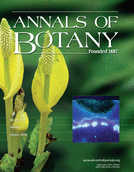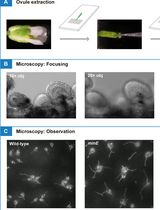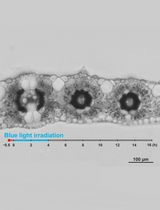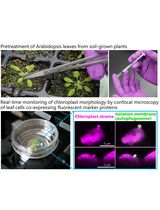- EN - English
- CN - 中文
Cytohistological Analyses of Mega-sporogenesis and Gametogenesis in Ovules of Limonium spp.
补血草属胚珠中大孢子发生和配子形成的细胞组织分析
发布: 2016年11月05日第6卷第21期 DOI: 10.21769/BioProtoc.1983 浏览次数: 7386
评审: Marisa RosaAleksandr GavrinAnonymous reviewer(s)
Abstract
Limonium spp. are known to have sexual and apomixis (asexual reproduction through seeds) reproductive modes. Here, we present dissection protocol developed for ovules of Limonium spp. using differential interference contrast (DIC) microscopy. This protocol permits better handling of ovules and offers certain advantages over earlier techniques particularly in larger ovules. This method also enables observation of meiosis and embryo sac development in intact ovules, and the ready detection of events distinguishing sexual and apomictic development.
Background
To describe the events that occur during ovule development it is necessary to cytologically examine ovules. This study can involve microscopic observation of paraffin- or resin-embedded, sectioned material, or cleared organs. The first cytological investigations into ovule and embryo sac development in sexual and apomictic Limonium species were published in the pioneer works of D’Amato (1940; 1949). In these works, flowers were fixed using the Karpechenko’s method, embedded in paraffin, sectioned and stained with Heidenhain’s iron haematoxylin, which stains chromatin and chromosomes in the cell nuclei. Flower buds sectioning using these methods can result in preparations with poor quality, due to partial disruption structural integrity of individual cells. A more facile alternative is clearing formalin:acetic acid:ethyl alcohol fixed organs and staining with pure Mayer’s hemalum (Wallis, 1957; Stelly et al., 1984). This technique requires much less time and labor, particularly for species which usually only form a small ovule within the ovary, which is the case of Limonium spp. However, in both small and large ovules chloral hydrate worked better than methyl salicylate as a clearing solution, because in this latter fluid ovules become quite fragile and difficult to handle during experiments. Our approach with an enzymatic digestion of ovules helps to reveal the central mass of tissue, the nucellus and the two integuments it covers, particularly in large ovules. Examples of meiotic and ameiotic ovules and embryo sacs cleared in chloral hydrate were observed under differential interference contrast optics.
Materials and Reagents
- Glass microscope slides (Belden, Hirschmann, catalog number: 8210101 )
- Diagnostic microscope multiwell slides (Thermo Fisher Scientific, Thermo ScientificTM, catalog number: 101432648 EPOXY )
- Glass coverslips (24 x 50 mm) (Belden, Hirschmann, catalog number: 8000119 )
- Teasing needle (BioQuip Products, catalog number: 4751 )
- Micropipette tips (2-20 μl, 20-200 μl, 100-1,000 μl) (Eppendorf)
- Six to eight months old Limonium plants in the flowering period
- Formaldehyde (36% aqueous solution) (VWR, catalog number: 20909.290 )
- Glacial acetic acid (Thermo Fisher Scientific, Fisher Scientific, catalog number: 10304980 )
- Distilled H2O
- Ethanol (absolute 99.5%) (Thermo Fisher Scientific, Fisher Scientific, catalog number: BP2818500 )
- Hematoxylin solution, Mayer’s (Sigma-Aldrich, catalog number: MHS16 )
- Chloral hydrate (Sigma-Aldrich, catalog number: 15307 )
- Cellulase (Sigma-Aldrich, catalog number: C1184 )
- Cellulase ‘Onozuka R-10’ (Serva, catalog number: 16419 )
- Pectinase (Sigma-Aldrich, catalog number: 6287 )
- Citric acid-1-hydrate (Sigma-Aldrich , catalog number: 33114 )
- Sodium citrate dihydrate (AppliChem, catalog number: 131655 )
- FAA solution (see Recipes)
- Dehydration solutions (see Recipes)
- Hydration solutions(see Recipes)
- 0.1% chloral hydrate (see Recipes)
- Enzymatic mixture (see Recipes)
- 1x EB (Enzyme buffer) (see Recipes)
Equipment
- Forceps with extra fine tips (Rubis forceps [BioQuip Products, catalog number: 4524 ])
- Glass watch glasses (O.D. 25 mm and 40 mm) (Sigma-Aldrich)
- Stereo microscope (Leica, model: WILD M3Z LEITZ )
- Fluorescence microscope (Carl Zeiss, model: Axioskop 2 )
- Differential interference contrast (DIC) optics
- Micropipettes (2-20 μl, 20-200 μl, 100-1,000 μl) (Eppendorf)
- AxioCam 289 MRc5 digital camera (Carl Zeiss)
Software
- Adobe Photoshop 5.0
Procedure
文章信息
版权信息
© 2016 The Authors; exclusive licensee Bio-protocol LLC.
如何引用
Róis, A. S. and Caperta, A. D. (2016). Cytohistological Analyses of Mega-sporogenesis and Gametogenesis in Ovules of Limonium spp.. Bio-protocol 6(21): e1983. DOI: 10.21769/BioProtoc.1983.
分类
植物科学 > 植物细胞生物学 > 细胞成像
细胞生物学 > 细胞成像 > 固定细胞成像
您对这篇实验方法有问题吗?
在此处发布您的问题,我们将邀请本文作者来回答。同时,我们会将您的问题发布到Bio-protocol Exchange,以便寻求社区成员的帮助。
提问指南
+ 问题描述
写下详细的问题描述,包括所有有助于他人回答您问题的信息(例如实验过程、条件和相关图像等)。
Share
Bluesky
X
Copy link













